Genesis
The ИС or Ио́сиф Ста́лин (Iosif Stalin) tanks family was driven by Stalin's obsession for heavy tanks, only matched by Hitler's own obsession of "super-tanks" as well as for practical reasons: The T-34 was no more a match for Germans tanks after 1943. The IS-4 was still in the straight line of successors for the KV-1 and followed the path of the IS-2 heavy tanks (1944). These tanks had a 120 mm set as a new standard, that can also provide a potent infantry support with its heavy HE shells. At the time the first lines of the IS-3 were drawn in 1944, the very same team (LKZ) and development bureau was working on an alternative model, the IS-4. The latter was conceived as a less advanced, therefore cheaper version of the IS-3 but differed considerably on several points. It was delayed, then later produced, and seen as an overall less successful design. It will be sent to a less important theater of operation for its entire cold war service duration and is nowadays largely eclipsed by the IS-3.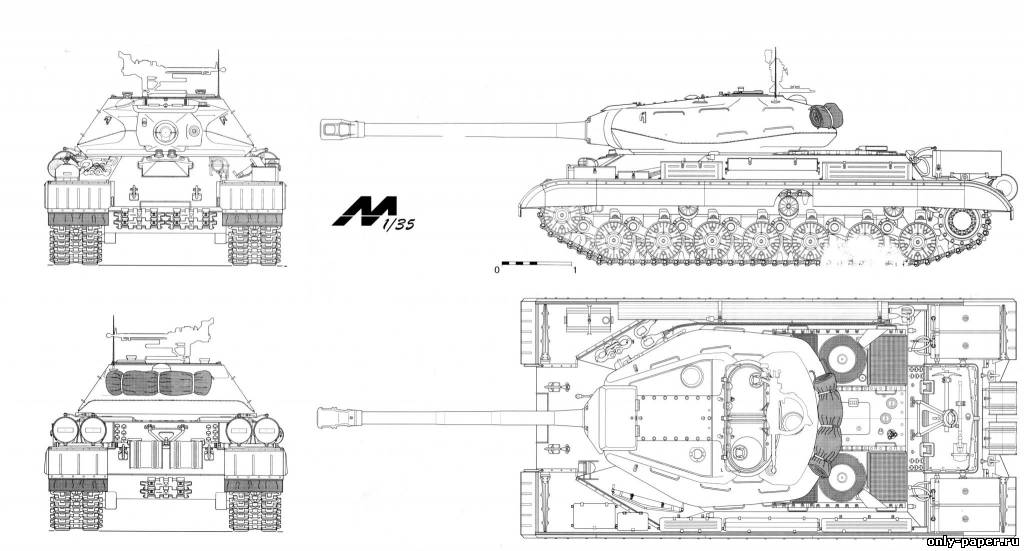
Development
The first prototype in 1945 was the Object 701-1 (Early IS-4 prototype), followed by the Object 701-2, which both were armed with the 100mm S-34 main Gun (30 rounds) and had a combat weight of 55,900 kg, and a 750 hp diesel engine. Three more prototypes were built, as the Object 701-5, which tried the 122mm D-25T main Gun. They had a combat Weight of 58,500 kg. At the end, the Object 701-6 was produced in 1946 and was given the final 122mm Rifled Gun D-25T (30 rounds). The engine was unchanged, as well as the armor. Power-to-weight ratio was then 12.39 hp/ton. Trials were successful, however, and the Object 701-6 was approved on 29 April 1946 by USSR Council Decree 961403 as the IS-4, and 250 were ordered (perhaps only 219 built) at a unit cost of 1 million 1947 Rubles.Design of the IS-4
This "little" brother, however, is interesting because of its direct affiliation with the IS-2. It looked like indeed as an IS-2 put on steroids. Although the hull general design was kept, only thickened, it was lengthened and fitted with an extra set of road wheels to cope with the extra weight and equipped with a much-improved engine. The latter was given a much-refined cooling system, influenced by the layout of the Panther tank engine compartment, which was thoroughly studied. The armor upper glacis plate was 140 mm thick at 61°, the lower beak plate was 160 mm thick at 40°, while the floor, upper and lower engine decks were 30 mm thick. The engine deck back plate was 100 mm at 38° and the rear beak was also 100 mm at 32 and 39°. The sides were 160 mm strong, sloped at 30° for the upper part and flat on the lower part, which was exceptionally thick. The glacis-sides linkage and particular shapes were reminiscent of the 1941 T-50 light tank. Indeed, while the beak formed a 120° angle between the lower and upper plate to reduced the front and increase the chances of shells bouncing off, the front plate (forming a "Vee") like on the IS-3 had was wide as the hull width between roadwheels. It then degraded into side slopes with two intermediary faces running towards the middle of the turret ring.
The driver was located in the center and was given two periscopes and a small one-piece hatch, right at the front of the turret ring. Headlights protected by armored covers were installed on the left-hand side of the front slope, while storage boxes and tooling, including a steel towing cable, were installed on each side, partly fixed on the narrow catwalks. At the rear sat the engine compartment, with fuel tanks behinds (410 Liters), and provision for four 90 Liter cylindrical external tanks (one pair on each side) and two smaller drum-type tanks installed on the back panel. The main engine was the same V12 750 diesel used on the IS-2 and IS-3, but due to a metric weight of 58 tons, performances were quite reduced, with a top speed of 43 kph and probably 20-25 kph off-road. There were a set of height roadwheels, including two raised-up at the front, used as tensioners, and two rear drive sprockets. The doubled roadwheels were suspended by individual torsion bars units. The very large tracks reposed on three heavenly spaced doubled return rollers per side. Ground Clearance was 41 cm.
The cast turret was directly based on that of the IS-2 but was given a radical increase in armor. It was made of two parts (upper and lower turret) welded together, like previous turrets. The front mantlet was 250 mm thick, sides were 200 mm thick at 35° and the rear 170 mm. The roof was a single, two-side plate 30 mm thick, welded on the upper cast part of the turret.
Three crewmen were located there, the gunner to the right-hand side, with his own periscopic sight, the commander periscope was on the left, and behind were located two large access one-piece doors, folding backwards, the right-hand side was given a periscope for the loader, while a smaller rotatable one-piece round hatch was given to tank commander on the left, with a periscope. A ring mount, which could be used either by the loader or commander was installed to the rear, for a DsHk 12.7 mm AA heavy machine gun. A mushroom-type exhaust vent was installed at the extreme rear of the roof for extracting fumes and ventilation. For infantry to ride on the tank, the turret sides had seven welded-on handbars.
On the turret rear fasteners for rolled canvas or haversacks were also welded on. At least several alternative armaments were studied on paper but ultimately for the sake of commonality, the mount of the original 122 mm gun was retained, with a coaxial PKT light machine gun, but the tube was bored to 125 mm. The main gun was identical to the IS-3 and IS-2 guns and was characterized by heavy two-parts rounds. The rate of fire was the same as to the IS-3 and quite slow compared to western and in particular US tanks of the 1950s. But it was capable of defeating 120 mm of sloped armor at 1000 m. Real performances were only estimated indirectly, by seeing the performances of Syrian and Egyptian IS-2/IS-3s. No doubt that the IS-4 would have been formidable opponents anyway for the M26 Pershing and M46 Patton, completely impregnable to their 90 mm gun.
Active service
The tank was approved for mass production in 1947 and put into service the same year, at the heat of the cold war. First tests in operational units shown rapidly its Achilles heal resided in a generally poor mobility, which concerned the top speed, agility as well as endurance. Because of this only 250 were built before the order came to cancel the project in 1949, after a two-year production. The whole batch was then transferred to a less important theatre of operations, the far east military region which borders are common with Mongolia, Korea, and China, and facing Japan. They were ready in preparation for the planned Soviet intervention in the Korean War, which never came. The IS-4 was retired from service in the early 1960s. Only one example survived, now displayed at the Kubinka Tank Museum, near Moskow in Russia.IS-4 related links
The IS family (generic) on WikipediaVideo: Inside the Chieftain's hatch: IS-4, Part 1
Gallery
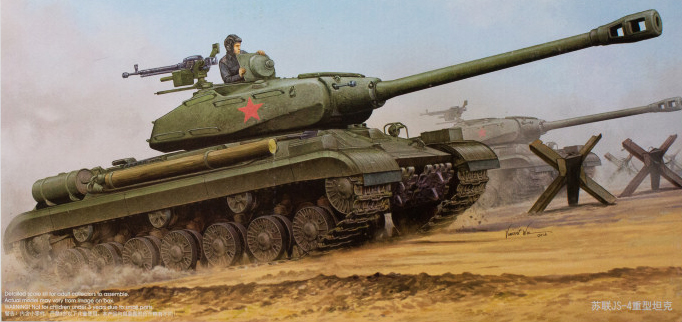
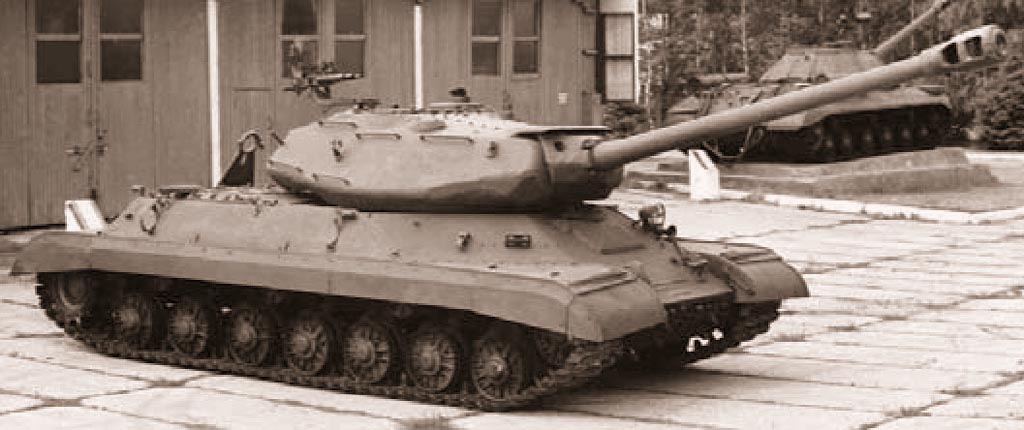
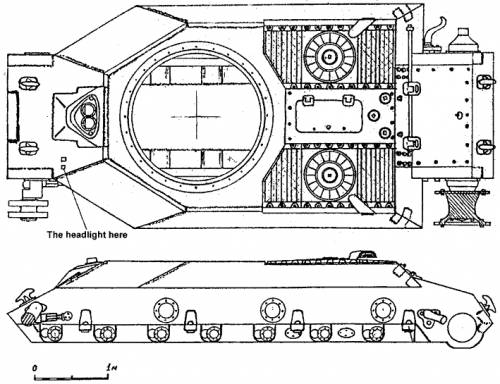
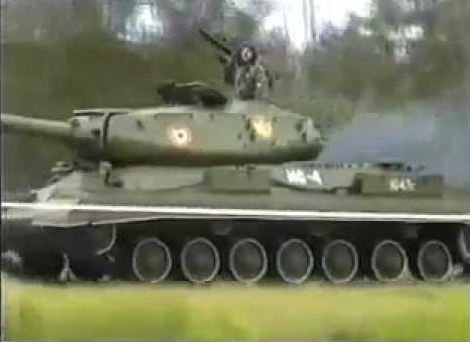
IS-4 specifications |
|
| Dimensions (L-w-h) | 9.70 x 3.26 x 2.48 m (354 x 118.1 x 78.5 in) |
| Total weight, battle ready | 58,5 Tons (117,000 lbs) |
| Crew | 4 (Driver, TC, loader, gunner) |
| Propulsion | V-12 Diesel (750 hp at 2,100 RPM) p/w 13 hp/ton |
| Top Speed | around 43 kph (26.7 mph) |
| Range | 100 km (65 mi) for 410+360 Liters external |
| Armament | 1 x D-25T 122 mm (30 rounds) 12.7 mm (0.5 in) DSHK AA MG, 1 coaxial 8 mm (0.8 in) PKT LMG. |
| Armor | 30 to 250 mm (1.18 to 9.84 in) |
| Total production | Approx. 250 |

IS-4 in exercises, 1947.

IS-4 in parade livery, 1947.

Cold War Tanks


































Cold war tanks posters

Cold War Main Battle Tanks

Cold War Soviet Army

